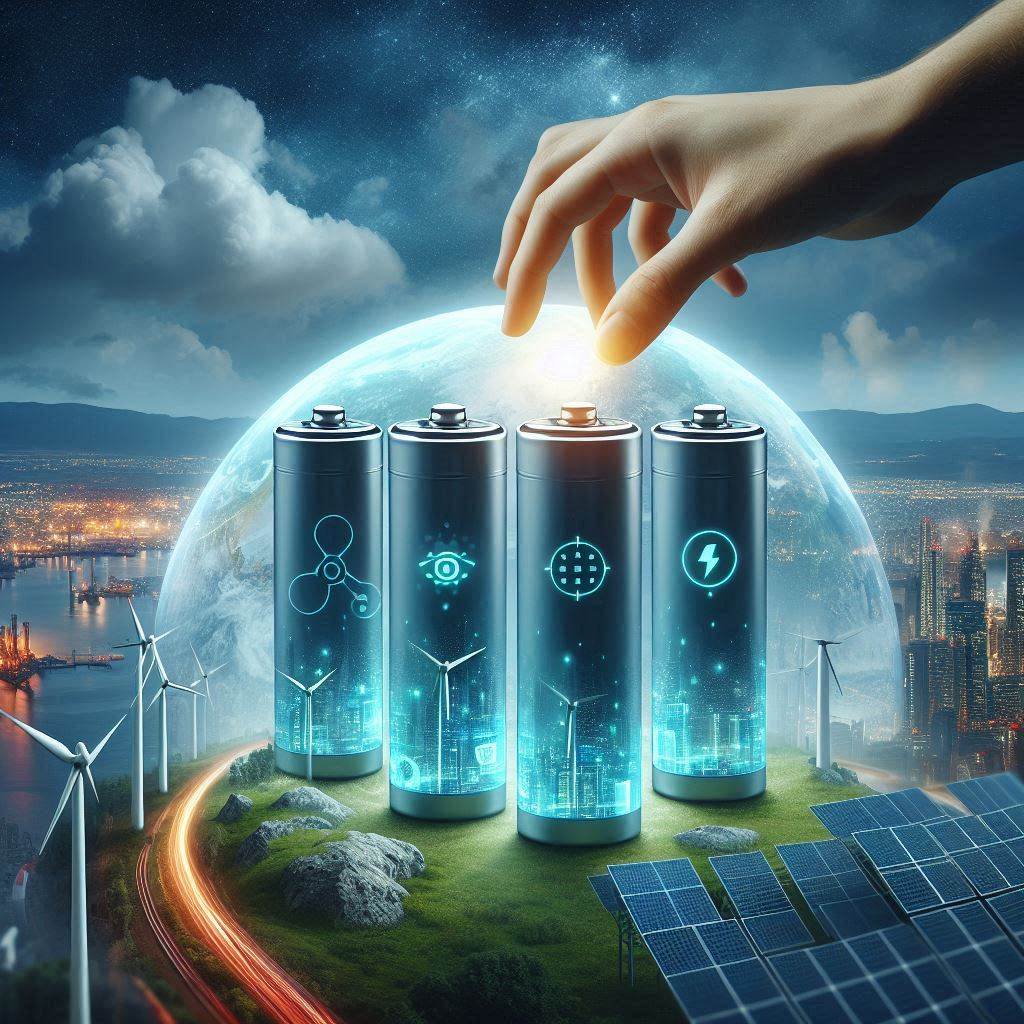As renewable energy sources like solar and wind become more prevalent, the need for efficient energy storage systems is critical. Traditional lithium-ion batteries have been the standard for storing renewable energy, but they have limitations such as limited lifespan, safety concerns, and dependency on rare minerals. Fortunately, new battery technologies are emerging that promise to revolutionize energy storage, making it more efficient, sustainable, and cost-effective. Here’s a look at some of the most promising new battery technologies that could be the next big thing in renewable energy storage.
1. Solid-State Batteries
Solid-state batteries are one of the most talked-about advancements in battery technology. Unlike traditional lithium-ion batteries, which use a liquid or gel electrolyte, solid-state batteries use a solid electrolyte. This change offers several benefits:
- Higher Energy Density: Solid-state batteries can store more energy in a smaller space, potentially doubling or tripling the capacity compared to lithium-ion batteries. This makes them ideal for use in electric vehicles (EVs) and grid storage, where space and weight are crucial factors.
- Improved Safety: The solid electrolyte is less likely to catch fire or explode than liquid electrolytes, significantly reducing the risk of thermal runaway. This makes solid-state batteries much safer for large-scale energy storage applications.
- Longer Lifespan: Solid-state batteries experience less wear and tear over time, leading to a longer lifespan. This makes them a cost-effective solution for both residential and commercial energy storage.
While solid-state batteries show great promise, challenges such as high production costs and scalability remain. However, ongoing research and development are expected to bring down costs and make these batteries more widely available in the coming years.
2. Supercapacitors: Speed and Durability for Short-Term Energy Storage
Supercapacitors are another exciting development in energy storage technology. Unlike batteries, which store energy chemically, supercapacitors store energy electrostatically. This difference gives them unique properties that make them highly suited for specific applications:
- Rapid Charge and Discharge: Supercapacitors can charge and discharge much faster than traditional batteries, making them ideal for applications that require quick bursts of energy. This is particularly useful in regenerative braking systems in electric vehicles, where energy must be captured and released rapidly.
- High Cycle Life: Because they do not rely on chemical reactions to store energy, supercapacitors can endure many more charge and discharge cycles than traditional batteries without significant degradation. This makes them exceptionally durable and long-lasting, with some supercapacitors rated for over a million cycles.
- Wide Temperature Range: Supercapacitors perform well across a wide range of temperatures, which makes them ideal for use in harsh environments where traditional batteries might fail.
While supercapacitors offer impressive advantages in terms of speed and durability, they do have limitations. Their energy density is much lower than that of conventional batteries, meaning they can’t store as much energy for their size. This makes them less suitable for applications where long-term energy storage is needed, such as powering a home or an electric vehicle over long distances. However, ongoing research is focused on improving their energy density, which could broaden their range of applications in the future.
3. Sodium-Ion Batteries
Sodium-ion batteries are an emerging alternative to lithium-ion technology, particularly for large-scale energy storage. Sodium is abundant and much less expensive than lithium, making sodium-ion batteries an attractive option for reducing the cost of energy storage.
- Abundance of Materials: Sodium is more plentiful and cheaper to source than lithium, reducing the cost of raw materials and making sodium-ion batteries more economically viable for mass production.
- Environmental Benefits: Sodium-ion batteries are environmentally friendly, as they do not rely on rare or toxic materials. This makes them a more sustainable choice for renewable energy storage.
- Improved Low-Temperature Performance: Sodium-ion batteries perform better in low-temperature environments than lithium-ion batteries, making them suitable for use in a wider range of climates.
Although sodium-ion batteries currently have a lower energy density compared to lithium-ion batteries, they are rapidly improving. Research is focused on enhancing their capacity and cycle life, which could make them a strong contender for large-scale renewable energy storage in the near future.
4. Iron-Air Batteries
Iron-air batteries are another promising technology on the horizon. These batteries use iron and oxygen to store energy, a simple and abundant material combination that could drastically reduce costs.
- Extremely Low Cost: Iron is one of the most abundant and inexpensive materials on Earth. This makes iron-air batteries potentially much cheaper than other battery types, especially for large-scale applications.
- High Energy Capacity: Iron-air batteries have a very high energy density, theoretically up to ten times greater than lithium-ion batteries. This makes them ideal for long-duration energy storage, such as balancing out intermittent renewable energy sources over days or weeks.
- Long Duration Discharge: These batteries can discharge over extended periods, making them suitable for storing energy for when the sun isn’t shining or the wind isn’t blowing.
The main drawback is that iron-air batteries are relatively bulky and heavy, making them less suitable for applications where space and weight are critical, such as in portable devices or EVs. However, for grid-level energy storage, they could provide an affordable and sustainable solution.
5. Flow Batteries
Flow batteries, or redox flow battery (after reduction–oxidation) are another innovative technology designed for large-scale energy storage. Unlike traditional batteries, which store energy in solid materials, flow batteries store energy in liquid electrolytes contained in external tanks.
- Scalability: The capacity of a flow battery can be easily increased by simply adding more electrolyte, making it highly scalable for grid applications.
- Long Cycle Life: Flow batteries typically have a longer cycle life than traditional batteries because the energy-storing materials are less prone to degradation. This makes them well-suited for applications where the battery will be charged and discharged frequently.
- Flexibility and Safety: Flow batteries can be more easily modified for different energy storage applications and have a lower risk of fire or explosion.
However, flow batteries currently have lower energy density than lithium-ion batteries, making them less suitable for applications where space is limited. Advances in materials and design could improve their efficiency and bring down costs, making them a viable option for both residential and grid-scale energy storage.
6. Lithium-Sulfur Batteries
Lithium-sulfur batteries are being explored as a potential successor to lithium-ion batteries, offering a higher energy density and lower cost. Sulfur is abundant and inexpensive, providing an eco-friendly and cost-effective alternative to the cobalt used in many lithium-ion batteries.
- High Energy Density: Lithium-sulfur batteries can potentially offer up to five times the energy density of traditional lithium-ion batteries, enabling longer-lasting energy storage in a compact size.
- Cost-Effectiveness: Sulfur is cheaper and more widely available than the materials used in lithium-ion batteries, potentially reducing the overall cost of energy storage.
- Environmental Sustainability: With fewer harmful materials, lithium-sulfur batteries offer a greener alternative to current battery technologies.
However, lithium-sulfur batteries face challenges with short lifespans and low cycle stability, as sulfur tends to dissolve in the electrolyte over time. Research is ongoing to develop more stable and longer-lasting versions of these batteries.
Conclusion: The Future of Renewable Energy Storage
As the world moves toward a future powered by renewable energy, advancements in battery technology are crucial to making this transition viable. From solid-state and sodium-ion batteries to iron-air, flow, and lithium-sulfur options, new technologies are being developed to overcome the limitations of current storage systems. These innovations promise to provide safer, more efficient, and more affordable ways to store clean energy, making renewable power a more reliable solution for everyday use and disaster preparedness alike. While some of these technologies are still in the early stages of development, they hold the potential to revolutionize the way we store and use renewable energy in the near future.
Meet Hajime, your passionate blogger-prepper who believes in empowering individuals and communities with the knowledge and skills necessary to make the art of prepping accessible and practical for everyone.






















